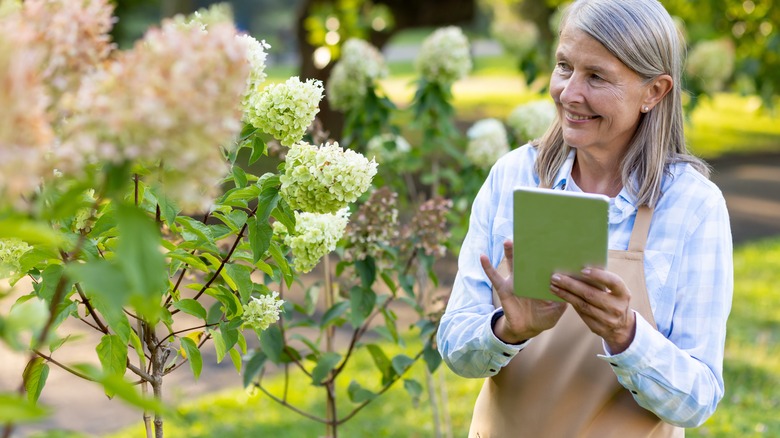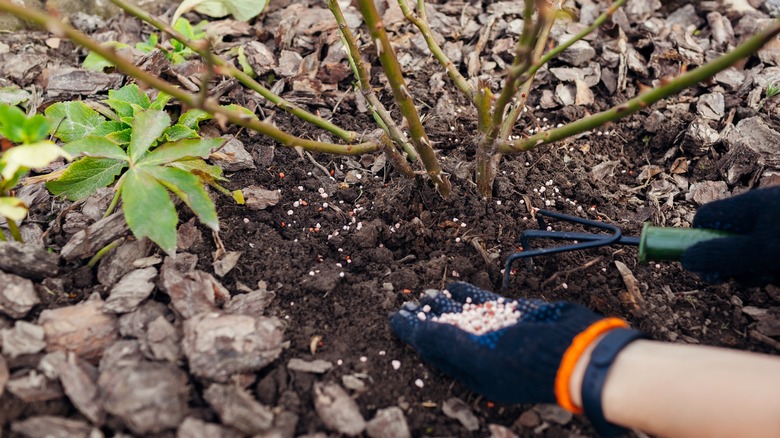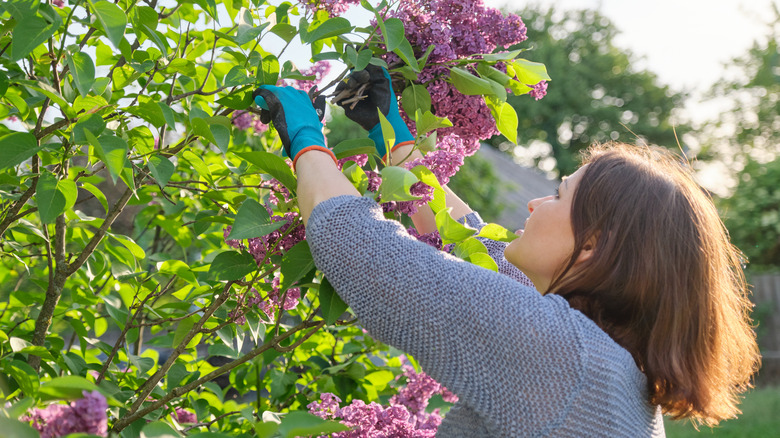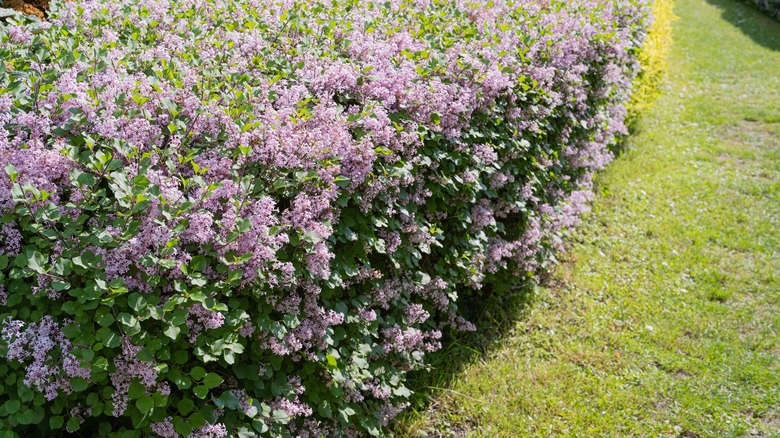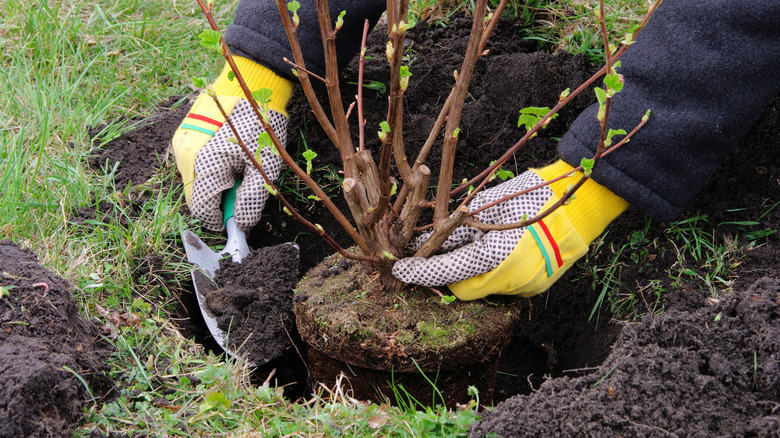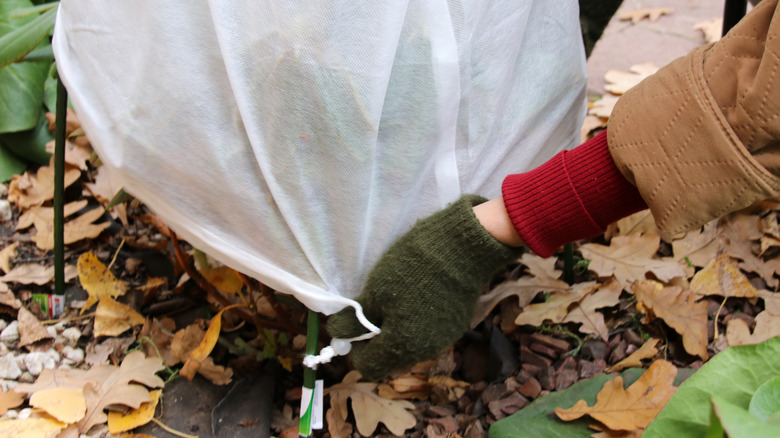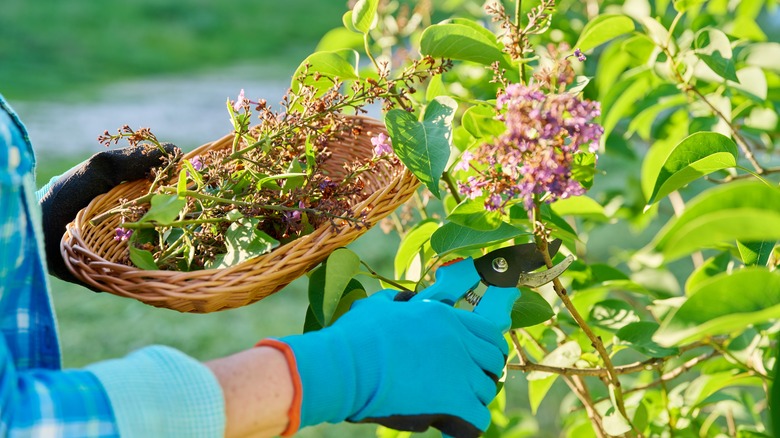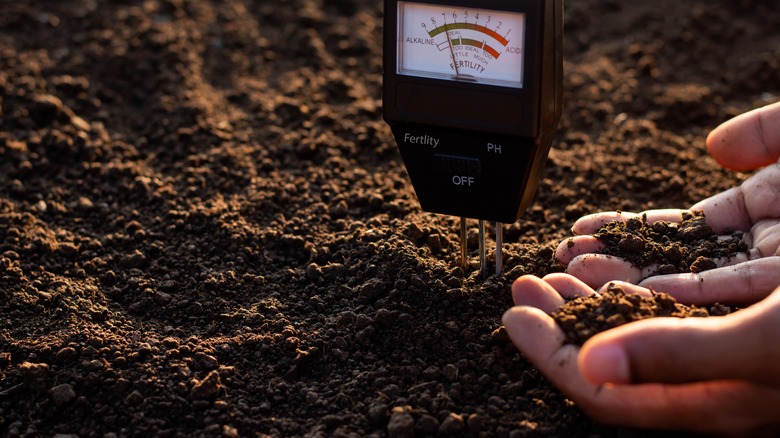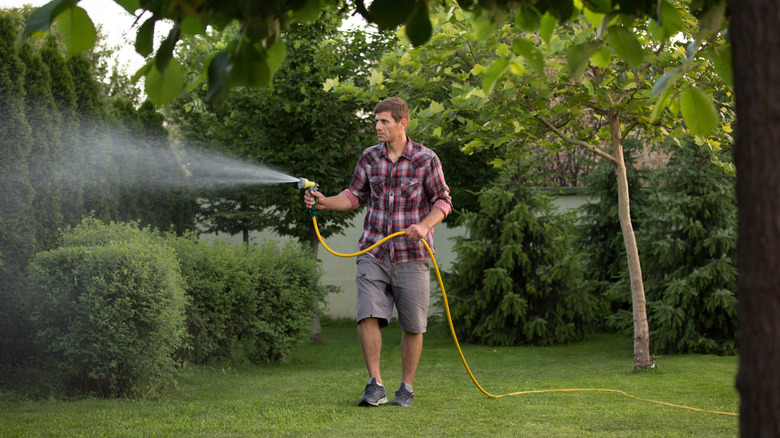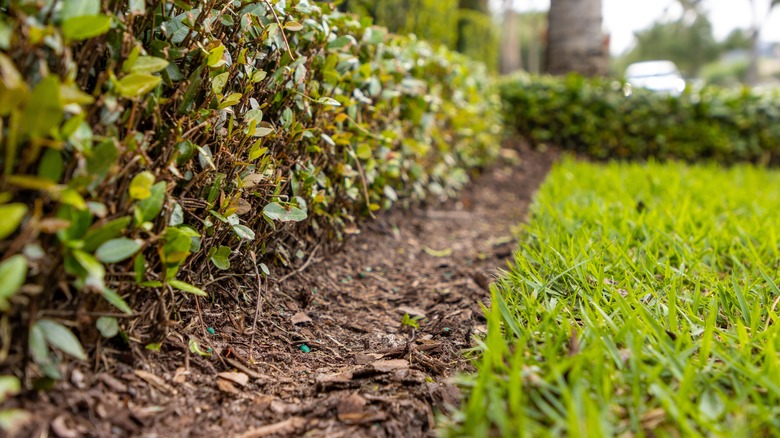Mistakes Everyone Makes When Growing Lilacs
Growing lilac bushes is a fun way to add pops of color with strong scents each spring. Their relatively straightforward care requirements and massive blooms make them a favorite shrub for gardeners, but there are many pitfalls when it comes to helping them along. Instead of focusing on just growing your lilacs, you want to know how to avoid these common mistakes to keep your lilacs as healthy as possible.
Each mistake can set your shrubs back, from putting them in the wrong spot in your yard to pruning at the wrong time. For example, lilacs love full sun; planting them in a space with limited sunlight exposure will cause fewer flowers. Not watering them correctly or using nitrogen-heavy fertilizers too much can impact growth or cause diseases (via Birds and Blooms).
You also have to understand the consequences of each error and why they can be so bad for your shrub. Failing to give them enough space, for example, causes poor air circulation and can lead to disease issues (via NH.gov). By zeroing in on these problems, you'll learn how to keep your lilacs healthier and blooming through the summer, filling your yard with a strong floral scent.
Not planting in full sun leads to powdery mildew and fewer flowers
One of the biggest things you need to know before planting lilacs is their sunlight requirements. Planting lilacs in partial shade creates issues. According to Iowa State University, your lilacs are more prone to having problems with a fungal disease called powdery mildew in shady spots because they tend to stay damp. It'll create a powdery, white growth over the foliage (via Arnold Arboretum). Also, not enough sun will impact blooms because lilacs in low lighting will not grow as large or healthy, dulling their springtime show.
To reduce your chances of the lilacs developing powdery mildew or having fewer blooms, put them in a spot with full sun. They'll need unobstructed sun exposure for at least six hours a day. If you have several bushes, space them several feet apart so they don't overshadow one another as they grow. To find an ideal spot, walk around your yard at different points during the day and note where the sun is in any shadowed corners. You'll know to avoid these spots when you plant.
Too much fertilizer leads to foliage growth but low blooms
A common reason your lilacs aren't blooming like they used to is you applied too much fertilizer. Lilacs and most flower shrubs don't need a lot of fertilizer. Adding too much, especially with higher nitrogen ratios, encourages lush foliage growth with fewer blooms. Nitrogen promotes leafy growth and takes the plants' energy away from producing flowers. The result is a very green lilac bush with a lot of foliage and low or no flower clusters. This drops the decorative charm of the shrubbery.
Around March, apply a thin layer of a balanced, 10-10-10 fertilizer. This is plenty to feed your shrub through the season without exceeding its nitrogen level. To make your soil more fertile, a few-inch layer of compost in late winter or early spring will inject nutrients as it breaks down and improves the soil structure. Another option is to sprinkle phosphorus-rich bone meal in the spring to promote healthy growth. Monitor how well your shrub grows and adjust your fertilization schedule to get a healthier bloom cycle in springtime.
Not pruning at the right time leads to bloom loss
Not knowing the best time to prune your lilacs to ensure it stays healthy is a huge mistake. You want to prune your shrubs in late spring. This timing is critical because your plants will set next year's flower clusters right after this year's blooms fade. If you don't prune until the fall or summer, there's a huge chance you could snip these buds and have fewer come springtime. Along with reducing how many flowers each shrub has come spring, it can stunt your plant's growth. If you don't prune them regularly and correctly, they can get overgrown and woody and set the stage for diseases. Also, older, unpruned shrubs usually produce fewer flowers and are less vibrant.
To maximize your shrubs' blooms, prune just after the flowers bloom. Remove any diseased or dead branches to help ward off fungal disease or pest infestations. Thin out the center of the bush to promote good airflow and light and cut away any suckers or new growth at the lilacs' base to ensure it puts more energy toward the main branches. Rejuvenation pruning is also possible for older, neglected plants, cutting back the whole thing to a foot above the ground when it's dormant.
Planting too close together causes poor air circulation
It is easy to ignore the amount of room your lilac shrubs need. This decreases air circulation within and around them, leaving them prone to disease. When you pack your plants in one spot, stagnant air builds up in the foliage, allowing blights and powdery mildew to take hold (via University of Minnesota). Left unchecked, these issues could kill your plant. Poor air circulation also stresses your lilacs, and they'll eventually produce fewer blooms or have a problem with dieback.
To prevent this, consider the plant's mature size when you're spacing them to plant throughout your yard. As a general guideline, Lombard Garden Club recommends 5 to 15 feet between your plants, depending on the cultivar. Larger shrubs will need more space. Measure the entire width of each mature lilac shrub and set half of this space on each side of your lilac and neighboring plants. This spacing stops any other branches from growing together and encourages good airflow. Thinning the bush's center by cutting out older problem branches enhances how much light and air gets through the plant to prevent mildew or fungal issues.
Not offering enough space for the roots
The roots of your lilac plant need to be able to spread out. Lilacs have extensive root systems and need enough room to grow to ensure the shrub has constant access to nutrients and water. When you confine them, the roots won't be able to establish themselves well, and this causes problems. Poor roots make your shrubs less stable, and they'll have more issues with drought stress because they can't reach deep water reserves. Also, being cramped can stunt their growth or flower production, leading to a smaller plant.
Each lilac shrub should have enough room for the roots to spread as it grows. Full Features Landscape and Garden Center notes that, when you plant them, the hole must be twice as wide as the root ball and as deep. This will help the roots extend outward as they mature. Pick a location big enough to host your fully-grown shrub's roots and canopy without it hitting anything. The soil should also be aerated and not compact; Loam works great. Check the soil conditions periodically and aerate at least once a year to let the roots breathe and improve the soil structure.
Failing to provide winter protection in harsh climates
Did you know you have to protect your lilac during the winter months to keep it healthy if you get severely cold weather? Lilacs are hardy, but extreme winter conditions can damage or kill young shoots. Lilacs planted in locations where the drainage is poor may suffer from root damage when the water around their roots freezes. Also, the freeze-thaw cycle can cause frost heaves, which stress your plants by moving the roots. Your lilacs are much less likely to survive and flower well in spring, and it can set growth back.
Mulch around your lilac bush's base with a thick layer of wood chips or bark to help insulate the root system from temperature fluctuations. NH.gov recommends about 3 inches of mulch. This mulch will not only protect the plant in the winter but hinder the growth of weeds in the spring and summer. You can also help your plants by reducing watering in the late summer to help the shrubs harden for winter.
Picking the wrong variety for your region
Picking the wrong type of lilac for your region is a common problem that can cause limited flowers and a shrub that struggles to survive. Lilacs have a broad range of cold hardiness and heat tolerance, and picking a variety that isn't suited to your area stops them from thriving. For example, some need cooler climates in the northern parts of the United States and won't do well in the southern states, and vice versa.
Research and pick out a lilac variety that matches your area's climate. Check and see your USDA Hardiness Zone and pick lilacs that fit into this zone. Stop by your local nurseries for a chat or contact your local agricultural extension office to ask about the most appropriate varieties. They'll help you find suitable choices for your area's typical weather and soil conditions and can give you tips to ensure they thrive.
Ignoring the soil pH
Ignoring your soil's pH levels when you grow your lilacs can cause issues. Lilacs like a pH range of 6.5 to 7.0. When it's too acidic, it hurts the plant's ability to access nutrients like magnesium and potassium. Acidic soil can cause nutrient deficiencies, stop the plant's roots from growing sufficiently, and can prevent lilacs from fully blooming.
However, you can easily monitor your soil pH and add chemicals to make the soil healthier. To keep your shrubs growing strong, you'll need a few things to measure your soil's pH. Measure the pH with a test kit or take a sample to your local agricultural extension service. If it's too acidic, Scotts recommends adding lime into the soil to boost the levels. Follow the package instructions to get the right amount. Retest your soil every few months and adjust it as needed to keep it within the ideal range.
Watering from above wets the foliage and leads to issues
Watering your lilacs from above is a common practice. When water hits the foliage instead of going around the base, it dampens the leaves. This is an ideal environment for leaf spot or powdery mildew to grow. This fungal infection is usually only aesthetic, but it can have health consequences for your plant if left untreated.
To keep your lilacs healthy, water them from the base to stop the water from sitting on the leaves. If the foliage is drier, pests or diseases will have a more challenging time taking hold. Use a drip irrigation system or a soaker hose to put water into the soil, focusing on the root zone. They use less water than a traditional sprinkler system, making them more efficient. Water your lilacs deeply (roughly a foot into the soil) to encourage deeper root growth to help them survive stress or drought.
Not mulching around your plant
Not putting any mulch around your lilac's base is a common mistake. Mulch helps suppress weed growth, locks moisture into the soil, and helps regulate the temperature around the roots. Without knowing how to pick the best type of mulch and how thick to lay it around your lilacs, your shrubs will compete with weeds for nutrients and water. This stresses your plants, especially if you have younger ones that haven't had time to grow deep roots. Unmulched soil also dries out faster, and constantly fluctuating moisture levels can impact plant health. The soil can get very warm in hot weather without protection, which may damage the roots.
To encourage healthy growth, apply a three-inch layer of organic mulch, like wood chips, in the spring. It'll also regulate the soil temperature to protect the roots. Leave a gap between the mulch and the lilac's stem to encourage good air circulation and ward off diseases or pest infestations. Add new mulch each spring as it breaks down to offer continuous protection to keep your shrub healthy and blooming.
